Quarterly balance of organised crime in Spain

Organised crime is one of the main threats that societies have to face, given its characteristics, as well as its virulence when it comes to affecting all levels of the population. This is why Sec2Crime has created the 'Report on organised crime in Spain', as an innovative research project that aims to create a basic strategic intelligence tool.
Thus, with this report we intend to put into context the first data extracted from the different police operations carried out in Spain during the first quarter of 2022 by the State Security Forces and Corps (FCSE).
The preparation of a report of these characteristics is new and, therefore, our theoretical framework is not framed in another report, but in the National Security Strategy of 2017 and 2021, and the National Strategy against Organised Crime and Serious Crime (2019-2023). We therefore draw on these sources to select the following areas of work and research:
- Drug trafficking
- Corruption
- Money laundering
- Cybercrime
- Trafficking in human beings
- Smuggling of migrants
- Intellectual property crime
- Fraud against the Public Treasury
- Crimes against property
- Illicit arms trafficking
- Crimes against the Environment
In order to prepare this document on organised crime in Spain, we monitor the news published in the press rooms of the National Police and the Guardia Civil. In this way, we gather objective information that is subsequently analysed and serves as the basis for the preparation of the report, as well as the quarterly balance sheets.
Introduction
Having analysed all the news relating to the areas of organised crime in Spain during the first quarter of 2022, we have sufficient information to provide an overview of the phenomenon of organised crime (OC) in our country. As indicated, the information we handle and analyse is obtained from official sources of the FCSE. Although the information is official, we expect a certain bias in the results obtained, as they only represent a percentage of the total operations carried out during this period of time. Therefore, the total figure would point to a higher result than shown in the analysis.
The quarterly balance sheet is structured around two main axes: on the one hand, police operations in each type of crime and, on the other hand, the criminal organisations dismantled. Finally, we will set out some conclusions on the evaluation of the data obtained.
Main monitoring areas
a) Police operations
In this first section, data on operations carried out by both the National Police and the Guardia Civil were analysed.
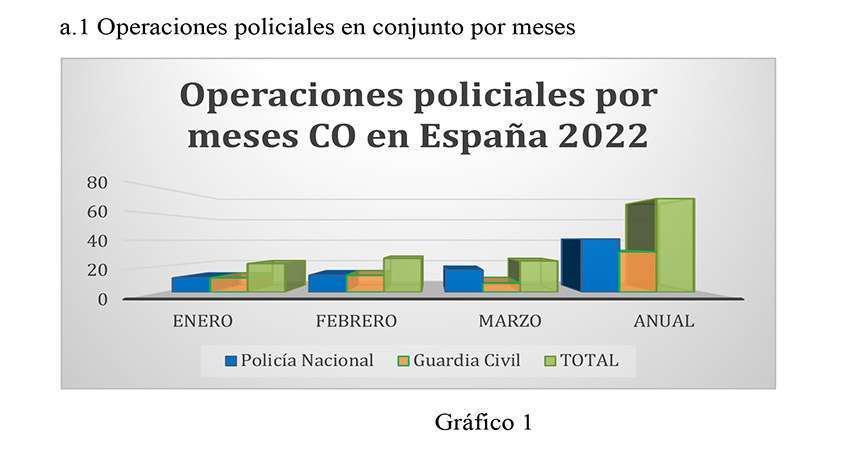
During this quarter, an upward trend was observed during the first two months. The graph shows a total of 72 operations carried out, of which the National Police carried out 41 (56.94%) and the Guardia Civil 31 (43.05%). 
This graph shows, activity by activity, the incidence of serious crime in Spain during the first quarter. The most relevant data are the 32 operations related to drug trafficking (47.05%) and the 15 in crimes against property (22.05%), which means a total of almost 70% of the crimes related to organised crime between both activities. 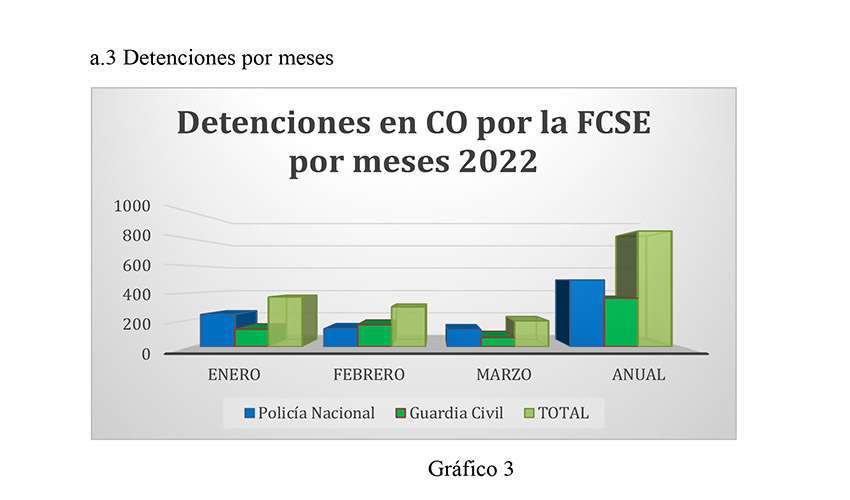
With regard to the arrests made by the FCSE in this first quarter, we note that, of the total of 858 people, the National Police arrested 497 people (i.e. 57.9% of those arrested), while the Guardia Civil arrested 361 people (42.07% of the total). All these arrests were mainly for drug trafficking and crimes against property.
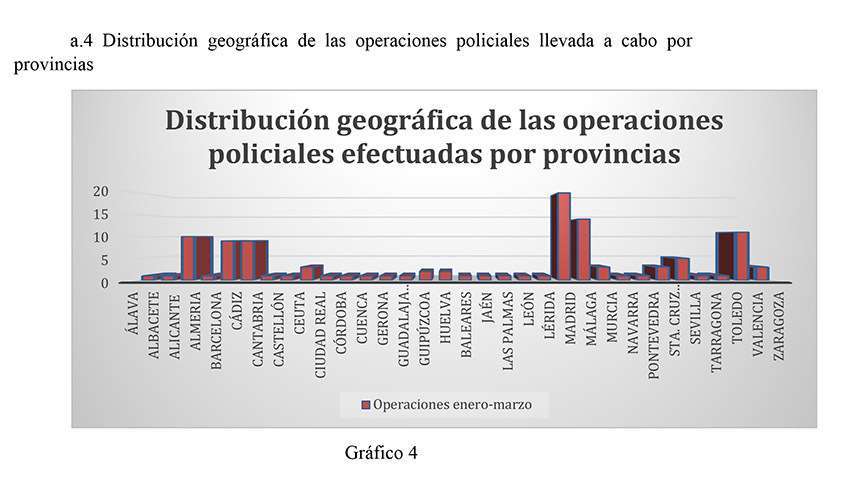
With regard to the geographical scope of the operations carried out by the FCSE in Spain during the first quarter, we note that operations were carried out in a total of 32 provinces. Madrid (20), Malaga (14), Valencia (11), Alicante (10), Cadiz (9) and Barcelona (9) stand out. In addition, many of the police operations take place in more than one province. In terms of Autonomous Communities, Madrid, Catalonia, Valencia, Murcia, Andalusia, the Canary Islands and Ceuta are the main centres of organised crime in Spain during this quarter.
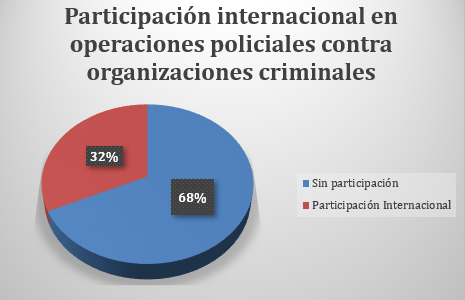
An indicator of the degree of threat posed by organised crime is the involvement of supranational security agencies (Europol or Interpol), as well as other countries (DEA, FBI, Carabinieri, among others), which highlights the transnational factor of organised crime in Spain. Of the total number of operations carried out, 23 (32%) involved international participation, and the remaining 49 did not (68.05%). These data show a priori that the main criminal organisations dismantled were not transnational in nature.
As can be seen from the data analysed and shown in the figure, the areas of greatest international involvement are drug trafficking, crimes against property and human trafficking.
Figure 7 shows the map of Spain with the information compiled and analysed in this section. Thus, this image shows an overview, as well as the worrying scenario regarding organised crime in our country during the first quarter.

b) Dismantled criminal organisations
Having analysed the data on organised crime, we must now focus on the characteristics of these criminal groups, through a series of data monitored in the news items analysed.
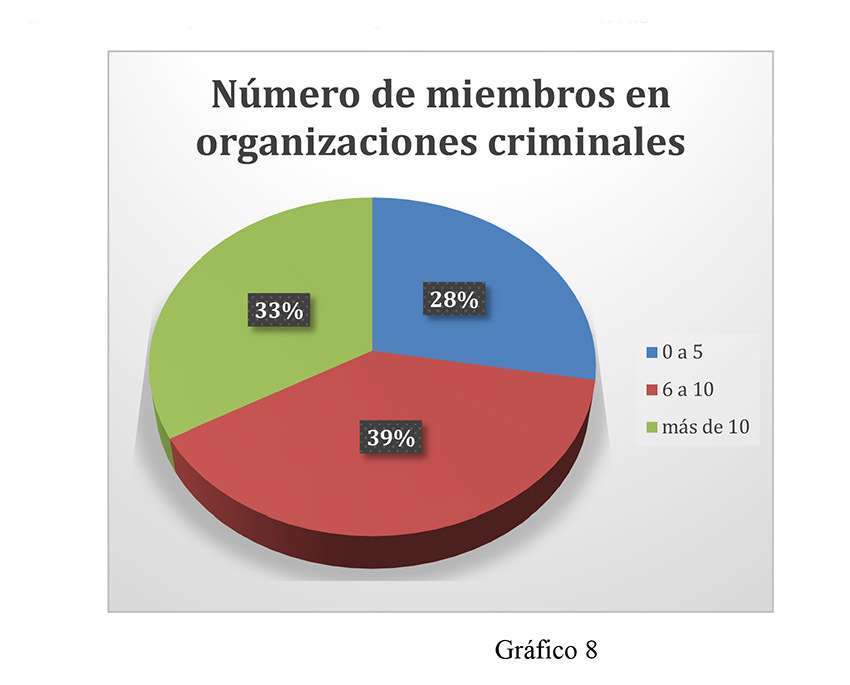 A relevant fact to understand the criminal markets and the individuals that make them up is to analyse the composition of the criminal organisations dismantled during police operations. We find, firstly, that up to 5 members are found in 20 groups (28%), secondly, from 6 to 10 members in 28 groups (39%) and, finally, more than 10 members in 24 groups (33%). From these data we can draw the following conclusions: on the one hand, about 72% of the groups are relatively large, and on the other hand, this implies a high degree of organisation and a relative hierarchy in the internal organisation.
A relevant fact to understand the criminal markets and the individuals that make them up is to analyse the composition of the criminal organisations dismantled during police operations. We find, firstly, that up to 5 members are found in 20 groups (28%), secondly, from 6 to 10 members in 28 groups (39%) and, finally, more than 10 members in 24 groups (33%). From these data we can draw the following conclusions: on the one hand, about 72% of the groups are relatively large, and on the other hand, this implies a high degree of organisation and a relative hierarchy in the internal organisation.
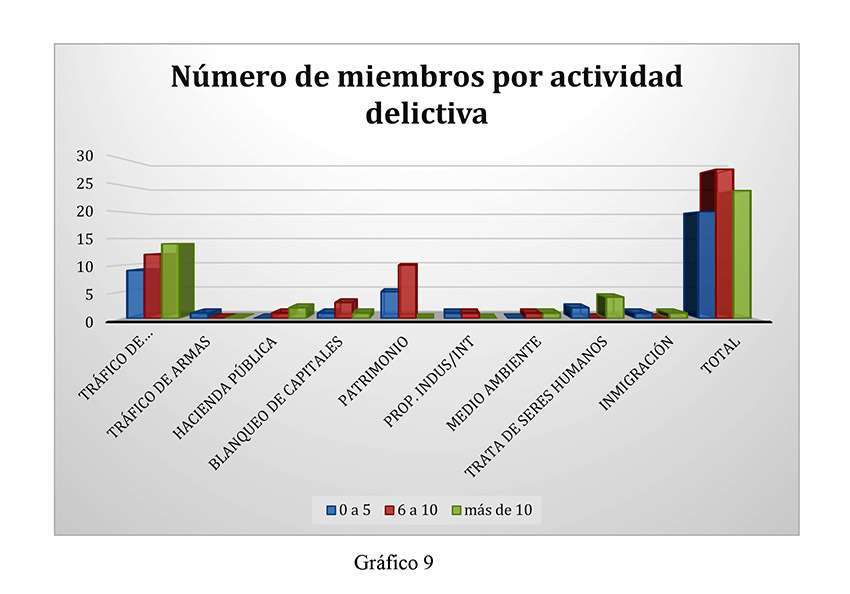
As can be seen from the data in Figure 9, drug trafficking and crimes against property are the most numerous groups, as well as trafficking in human beings. However, in drug trafficking, there are also a large number of relatively small groups.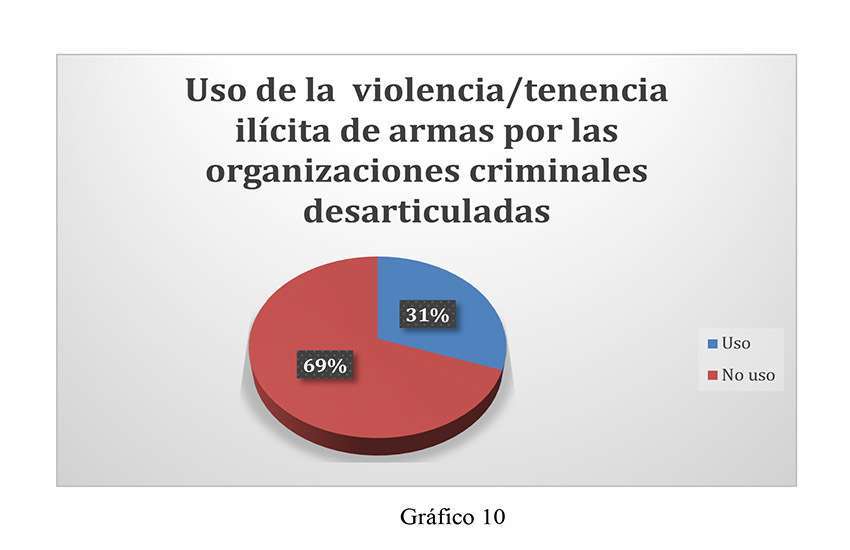
Offences related to organised crime tend to be associated with violent types of crime. To assess this indicator, the illegal possession of weapons by criminal groups dismantled (72) by the FCSE during the operations carried out in the first quarter was taken into consideration. From these data, we can see that, of the 72 groups that have been dismantled, firearms were seized in 22 of them, which represents 31% of the total number of seizures.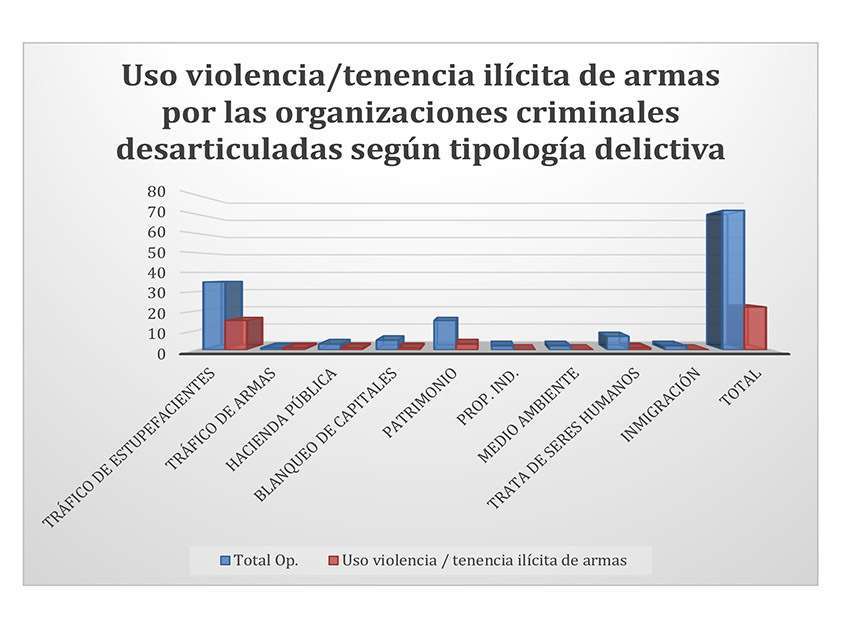
If we put the data in figure 10 into context with the one we are dealing with (figure 11), we can see that the criminal activities related to serious crime are drug trafficking, followed by crimes against property. In the first of these cases, the use of firearms is increasingly common in "overturns" between drug traffickers. In several of these cases, the weapons seized were considered to be weapons of war. 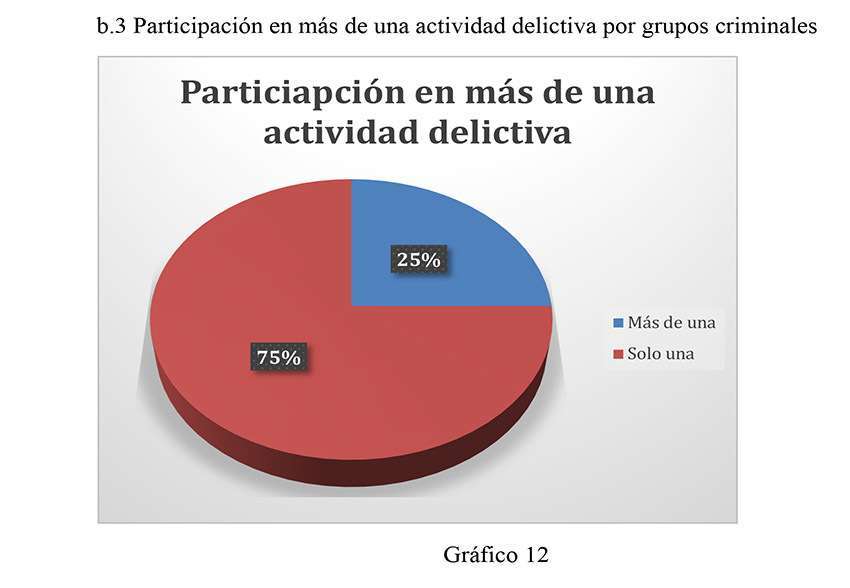
The fact that groups are involved in more than one criminal activity is one of the factors to be taken into account in determining the degree of relevance of organised crime in Spain. Of the 72 operations studied, we have found that this phenomenon occurs in only 18 of them, which translates into 25%. This data shows that the majority of criminal organisations are almost entirely dedicated to one type of crime exclusively, and maintains the same trend as that expressed by Europol in its Serious and Organised Crime Threat Assessment (SOCTA).
After monitoring and analysing the police operations carried out during the first quarter of 2022, and always based on the information officially published by the National Police and the Guardia Civil in their respective press rooms, we can draw the following conclusions:
- Of the activities considered as serious crime that are analysed in the Report, 11 in total, there have been 9 in these three months, which shows a worrying trend.
- Of those activities that represent a particular risk to society, drug trafficking and crimes against property are confirmed as the most worrying areas.
- In terms of territorial scope, police operations have been carried out in 32 provinces. These mainly affect the Levante, Andalusia, Madrid and Catalonia, which means that the geographical expansion of organised crime extends to more than half of the national territory.
- As regards the transnational nature of the criminal organisations dismantled, their presence in recent months has not been high. However, they are of particular interest in qualitative terms, given their international relevance.
- With respect to the typology of the organisations, we have observed that they are relatively large groups with a clear hierarchical structure.
- In terms of the use of violence, there have not been high figures during this quarter. As indicated, its use seems to be generalised in the area of drug trafficking with the aim of perpetrating "overturns" between the different criminal groups.
By way of general conclusion, in this quarter the situation regarding organised crime in Spain would remain at MEDIUM-HIGH risk, since, although some data are high, others show a downward trend. However, it should be noted that what has been analysed and published is only a percentage of what has actually occurred, to which must be added those operations that are not published, as well as those criminal organisations that continue with their activities and have not been dismantled. All this leads us to believe that if we take into account all the data, the risk would be HIGH.
Sec2Crime's research work continues, so we will have to wait for the data from the second quarter to be able to see how the phenomenon of organised crime is shaping up in our country as the months go by. This work will conclude with the publication of the Report at the beginning of 2023, which we hope will be a useful strategic intelligence tool both for the FCSE and for society as a whole.
José Luis Gil Valero, coordinator of the 'Report on Organised Crime in Spain 2022', Sec2Crime and analyst of Strategic Studies on Terrorism and Organised Crime.
Bibliography
- Departamento de Seguridad Nacional. Estrategia de Seguridad Nacional 2017. Consultar en: https://www.defensa.gob.es/Galerias/defensadocs/Estrategia_Seguriad_Nacional_2017.pdf
- Departamento de Seguridad Nacional. Estrategia de Seguridad Nacional 2021. Consultar en: https://www.dsn.gob.es/es/documento/estrategia-seguridad-nacional-2021
- Estrategia Nacional contra el Crimen Organizado y la Delincuencia Grave 2019-2023. Consultar en: file:///C:/Users/JLGV/Downloads/Estrategia%20Nacional%20contra%20el%20Crimen%20Organizado%20y%20la%20Delincuencia%20Grave%20-%20Interactivo%20(2).pdf
- Europol, (2021). Serious and Organised Crime Threat Assessment (SOCTA). Consultar en: https://www.europol.europa.eu/publications-events/main-reports/socta-report
- Gabinete de Prensa de la Guardia Civil. Consultar en: https://www.guardiacivil.es/es/prensa/noticias/index.html
- GIL VALERO, José Luis. ¿Es necesaria una memoria sobre criminalidad organizada en España? Entrada de Blog Sec2Crime, (2022) https://www.sec2crime.com/2021/12/30/memoria-sobre-crimen-organizado-en-espana/
- Sala de Prensa de la Policía Nacional. Consultar en: https://www.policia.es/_es/comunicacion_salaprensa.php
